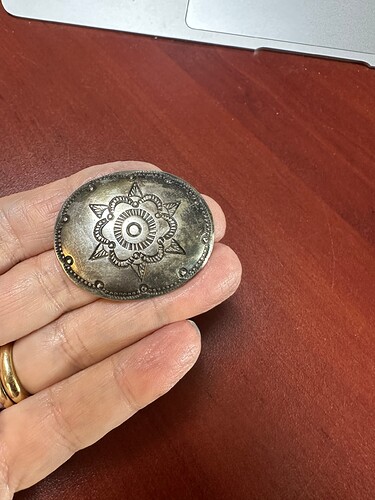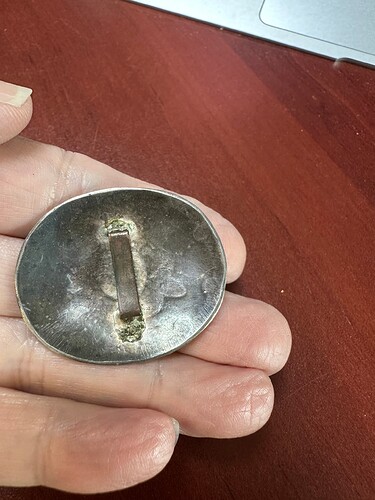Hello, I purchased 12 silver conchas from an estate sale and I have researched and believe they are Navajo. I tested for silver and they tested as coin silver. I would love any information you may have about these, especially a date range. Also, could they have been meant for a hat band or would it have been for a skinny belt? Thank you!
Is there any hallmark anywhere on the back of them?
Welcome to Turquoise People!
No there are no hallmarks
Hmmm… It will be hard to say for sure then if they are Navajo made, even though they have that look. Hopefully some people with more experience regarding conchos will jump in. And you are right they do look small, but I can’t tell if they’re small enough for a hat band.
Thank you. Still hoping someone can help me with dating these.
could you please expound
I’m no expert, however, I do have some opinions dependant upon answers to a few questions.
-
Could you please provide length and width dimensions?
-
Would it be too much trouble to photograph a few of these together, in the same orientation?
-
Do you have a scale that will display the weight in grams that you could separately weigh a few of them on?
-
I’ll be a pain with one last question, could you please post a clear photo of the stamp work, up close and focused, without too much influence from a light source? I only ask this because in the first photo, I can’t tell if the light is betraying my eye concerning stamp detail or if what I’m seeing is another anomaly.
Thank you for your reply.
They measure 1.5" long and 1.25" wide.
I’m attaching pictures showing weight and up close stamp work.
Thank you!
It’s going to be difficult to provide a date range for these without provenance of some type. My impression is that these are die struck. rather than hand stamped. Possibly two dies used. One for the outer pattern, and one for the center pattern.
Lots of this type of jewelry was made in small production shops during the Harvey era (which lasted decades) for relatively inexpensive sale to the tourist trade.
Key takeaways.
- Likey US made.
- Likely die struck production goods made in Native American style for the tourist trade.
- Unlikely ‘Coin Silver’, unless the shop making them was rolling out coins to produce them which would have been more expensive in terms of time than simply purchasing milled sterling sheet. The dimensions – 1.5" x 1.25" – are typical of items made from 6" wide sections of sterling sheet in a production environment.
- Probably a piece of Harvey era history. May appear in old trade publications or advertisements for authentication as to time frame.
Thank you so much for all that information!
I tested them but they did not test positive for sterling.
How did you test them?
I ordered a chemical test. I scrpaed the edge of one onto a stone and added the chemical that was made to test for silver. It looked positive for coin silver to me.
I’m definitely late getting back to this, my apologies. Thank you for sharing all of the requested photos and information.
Please know that my following statements are simply my opinions, and that I’m not standing on a soapbox pontificating.
I agree with @mmrogers. One observation that was apparent to me, when I first looked at the group photo of three separate conchos, was the similarities in stamp placement, supporting @mmrogers’ theory of these being struck in a die set.
In the photo below, I’ve placed a red line on the perimeter of each concho indicating the “reference” edge for my following observation. We could think of each of these conchos as a clock, and that red line indicates high noon.
The proximity of elements “1” and “2” to the center circular pattern are nearly identical, and if we were to rotate the middle concho so the reference edge (high noon) was shared among all three, element “3” is in the same location, and an identical distance from the center pattern, on all three conchos.
This kind of repetition would be nearly impossible to duplicate by hand. Studying work by some of the early master silversmiths such as Hosteen Goodluck and Etsitty Tsosie (who were also master toolmakers) there is evident variation in their stamp placement. Unlike what I just attempted to describe concerning these conchos.
The triangular element radiating from the central pattern seems to be lacking refinement. The peaks of what should be in high relief rather blend together and negate the valley that “should” be present between them. This can be caused by die damage, transfer of material in the punch, mis-strikes, any number of things. (This comes from my experience building, fitting and running off die sets for industry.)
The uniformity that presents on the reverse is telling as well, I feel. If struck by hand, there would be varying transfer and depth. From the one photo that shows the back side, it looks to me to be die struck as there is consistency in both the transfer and depth.
As for your main concern, dating, again I’m with Mike, it’s a tough call. I pointed out my observations, as Mike did, in order to shore up what follows. All points indicate, to me, that these were made in a production environment and more than likely hail from the Harvey era boom of jewelry production.
But hey, these are just my thoughts. ![]()
.
“Coin” often (but not always) indicates older work, which is a typically a value added selling point for someone aiming to offer an item for sale.
As for silver content, If you plan to sell these, you’ll want to have them tested by a jeweler with a proper nitric acid kit, the requisite experience to know exactly what to look for, and stand behind the results. The internet is forever, and you don’t want to be caught with your pants down inadvertently misrepresenting the nature of an item you’re listing.
That being said, @Ravenscry is an expert tool and die maker, and I’d take his assessment as true confirmation of the nature and origin of these pieces. While anything is possible, it’s unlikely someone stamping enough of these out to partially wear out the dies would be using coin silver, when milled sheet is readily available.
Good luck to you.
I might as well throw my 2 cents in. What silver test did you purchase? The most common contains Potassium Dichromate with concentrated Nitric acid (JSP brand).
Thankyou for your comments. I will take them to a jeweler to do a difinitive test. I am trying to find out as much as I can so I can list them in confidence.
Yes, that’s the one I used. JSP. Contains nitric & muriatic acid.
Thank you ever so much for all of this detailed information! I am very grateful!
I will do more research into the Harvey era and will take them to a jeweler to reconfirm the metal content.
Glad to (potentially) help. I scrounged through the Harvey catalogs on this website…
…to no avail. While seeing similar design elements and stamps, I didn’t find anything definitive, but thought there was perhaps a minuscule chance of finding a matching design. As @mmrogers touched on, there were an endless number of shops producing this style of jewelry for a long time.
Be sure to let us know what you hear from the jeweler!







